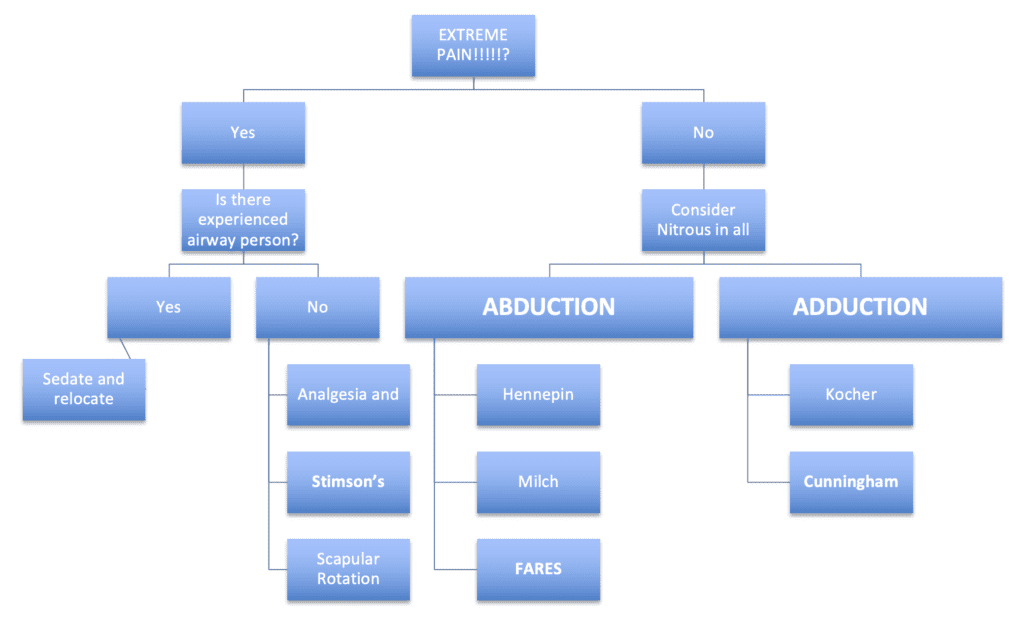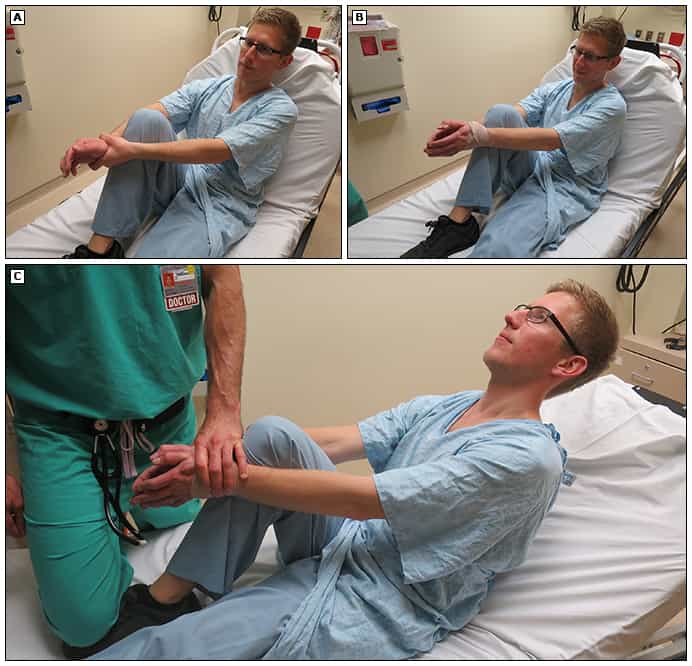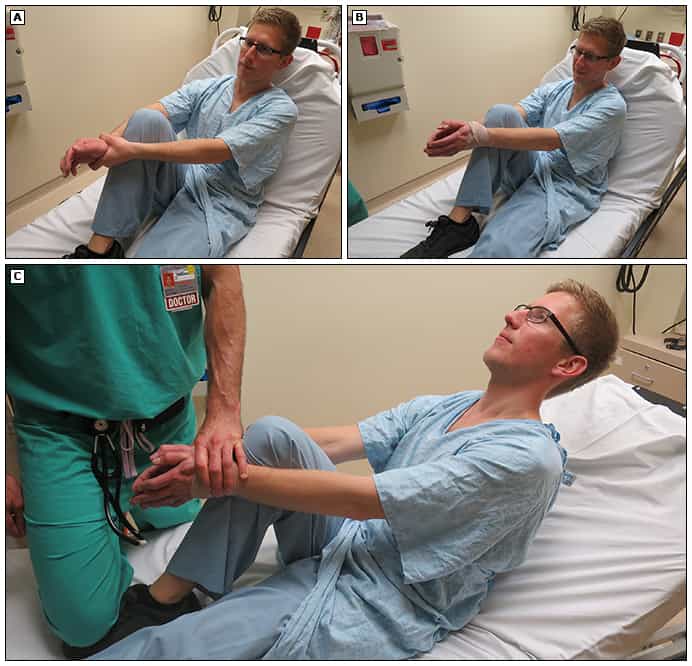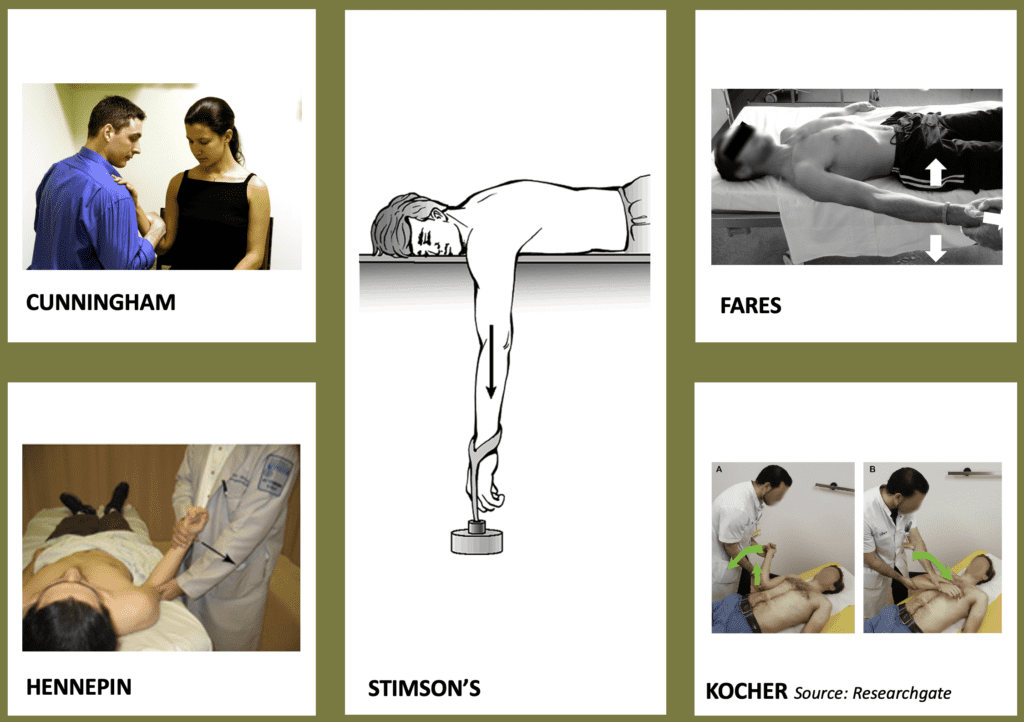Patients with shoulder dislocations are not an uncommon presentations to the Emergency Department. The ability to reduce the shoulder depends on many factors which include whether the patient can Adduct or Abduct, how painful the dislocation is. We know that in some patients, small movements, even with analgesia, can be very painful, and others will allow you to manipulate the shoulder, with some discomfort, but not becoming too distressed. The technique, should be matched to the patient.
In most cases reduction of the dislocation is facilitated by some form of axial traction.
Shoulder Dislocation Techniques
Before we discuss the Davos method itself, lets look at some of the other techniques available for relocation:
- Milsch: Hand on shoulder to steady humeral head, then ABDuct and externally the arm to the overhead position whist traction is applied, then push the humeral head back. This is sometimes called ‘pick an apple’
- Stimson: Patient lies prone, with a 5kg weight hanging from the arm (good for a single operator)
- Scapular rotation: Patient lies prone, with the arm hanging down as in Stimson. Push the tip of the scapula medially (ie., rotate it clockwise)
- Kocher’s: arm adducted, externally rotated and internally rotated- painful, risk of tears to inferior capsule
- First used by the Egyptians
- There is no traction here, only leverage: traction causes the complications of subscpularis tears and humeral head fractures
- How to perform:
- Bend the elbow at 90 degrees,
- ADDuct the elbow, then
- externally rotate to 75 degrees until there is resistance,
- then elevate and internally rotate so that the hand is towards the opposite shoulder.
- FARES– external rotate and abduct the arm and then swing the arm up and down
- Cunningham: relaxation and elongation by massage
- Hippocratic; patient supine, arm abducted, elbow flexed 90 degrees and traction applied DON’T DO THIS
- Hennepin: Externally rotate the shoulder, then ABDuct the arm
- Snowbird
- Eskimo: Lift the patient up by the dislocated arm DON’T DO THIS
- Spaso: supine patient- lift the arm straight up and externally rotate.
- Countertraction
- Davos: Will discuss below
My Previous Approach
The following is a flow diagram that I would use to determine which technique I used.
Important decision-making points were:
- Was I working alone?
- Did I have someone that was airway competent that could assist?
- Was the patient in such extreme pain that they would need sedation?
- Was the patient able to ABDuct or ADDuct? As this would assist me in determining the technique I would use.
The diagram looked a little like this:

My approach has changed as I try to use simpler, techniques that are well tolerated by the patient.
In a patient with good pain tolerance that can move their arm
If the patient can ADDuct the affected arm, I would use the Davos Technique first, followed by the Cunningham technique.
If the patient is ABDucting the arm, I would use a traction technique which might be incorporated into the Fares approach.
In a patient with significant pain that cannot tolerated movement of the arm.
I would initially use some nitrous with some analgesia. If no reduction was possible and I had a trained airway person on, we would proceed to sedation and reduction, with simple traction.
If I do not have a trained airway person on, or I am on my own, I would use Stimson’s method.
The Davos Method
The Davos Method, was first described in 1993 as a method of self-reduction of shoulder dislocations, without the need for sedation and with a high success rate. It is sometimes also referred to as the Boss-Holzach-Matter technique. Trials have found this to be a safe, well tolerated non-traumatic technique.
How to Perform the Davos Technique
- Give the patient analgesia
- The patient is seated.
- The knee, ipsilateral knee to the shoulder dislocation is flexed as is the ipsilateral hip.
- The patient must clasp their fingers around the flexed knee. If this is too difficult a bandage can be placed around the wrists.
- The foot of this ipsilateral flexed side is stabilised
- With the elbows ADDucted ask the patient to lean the head back extending the neck and roll the shoulders forward.
The neck extension puts traction on the shoulder reducing it.

Try it next time you have a suitable patient with a shoulder dislocation and you will be surprised.
More topics to look up:











